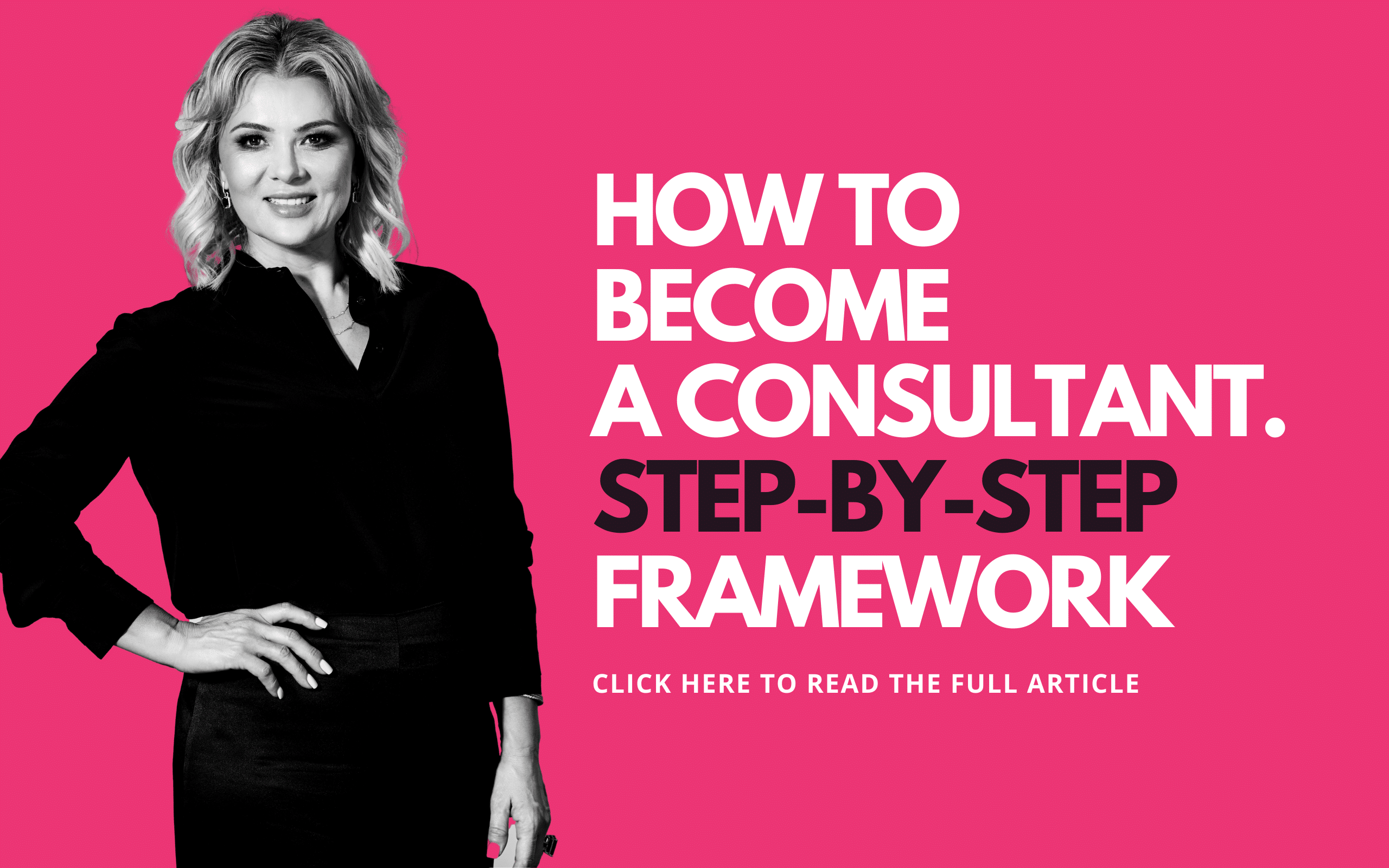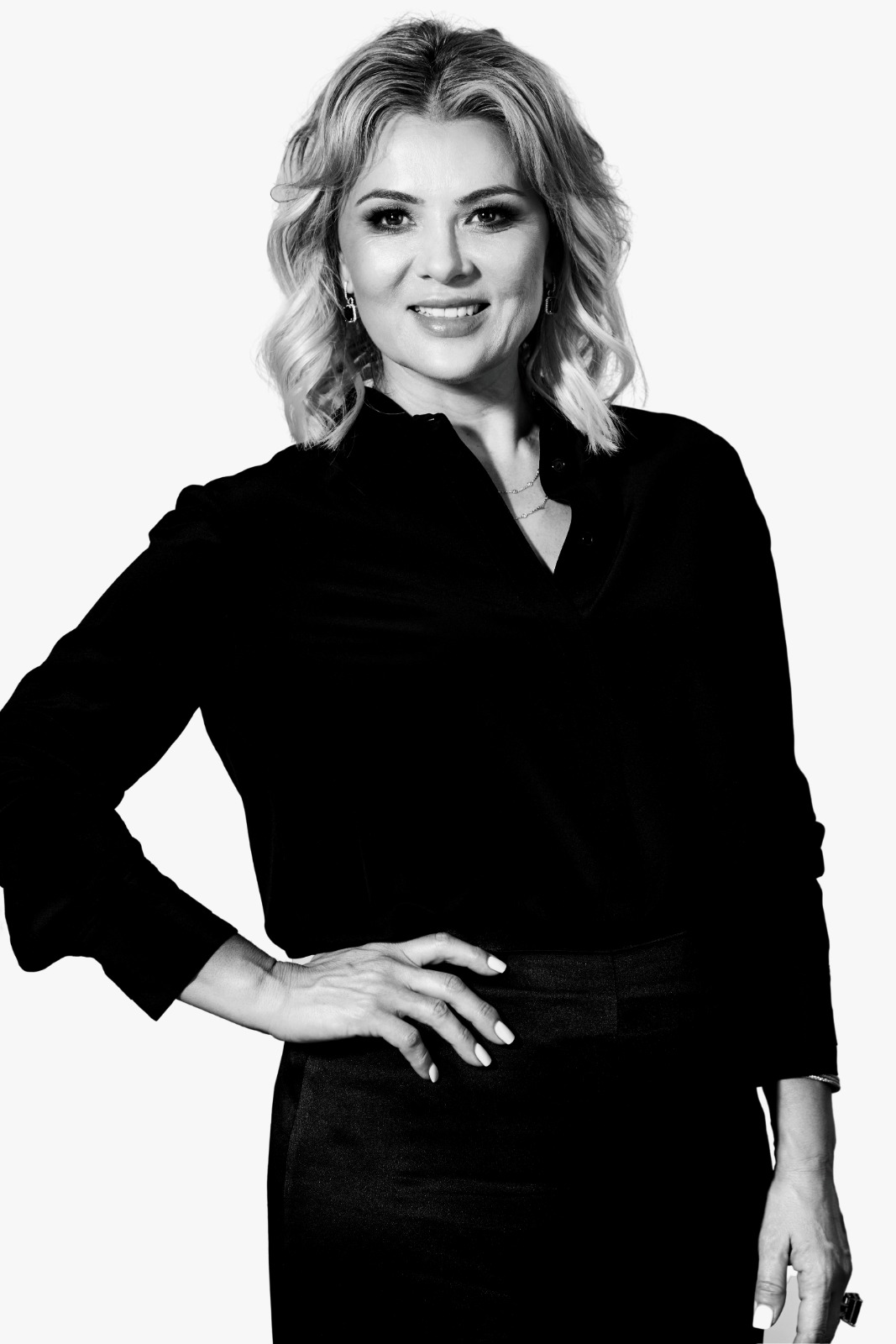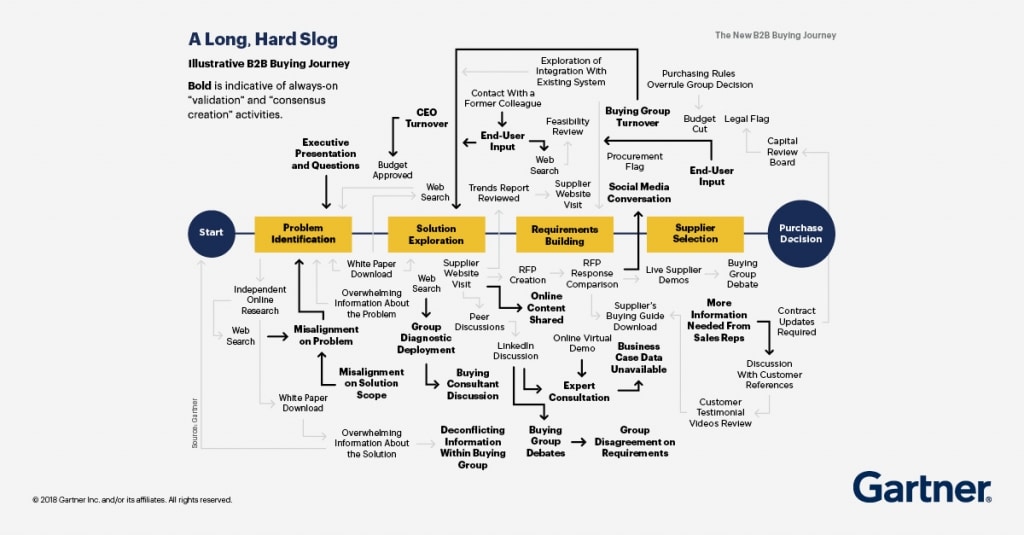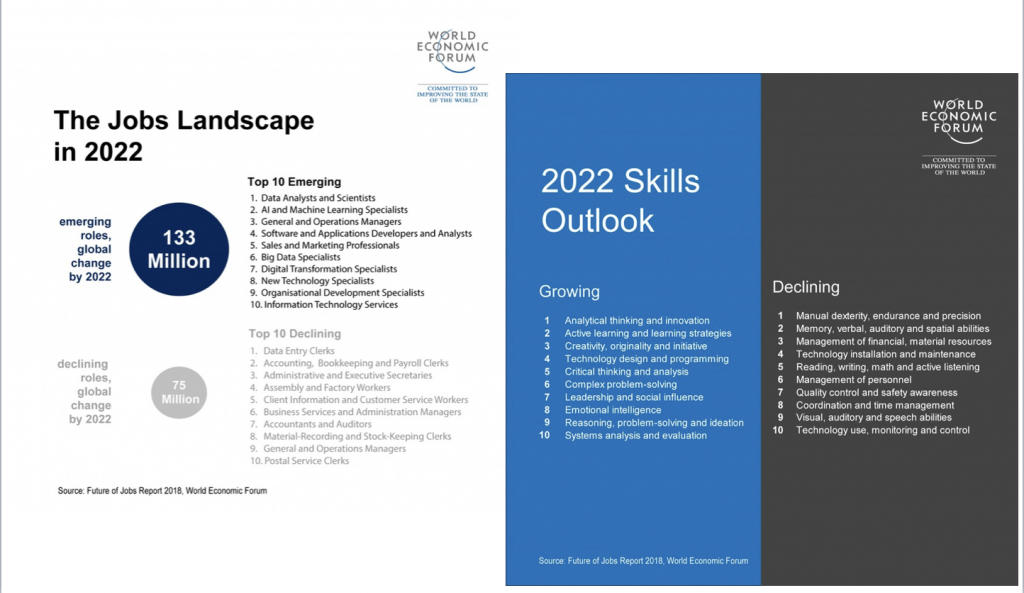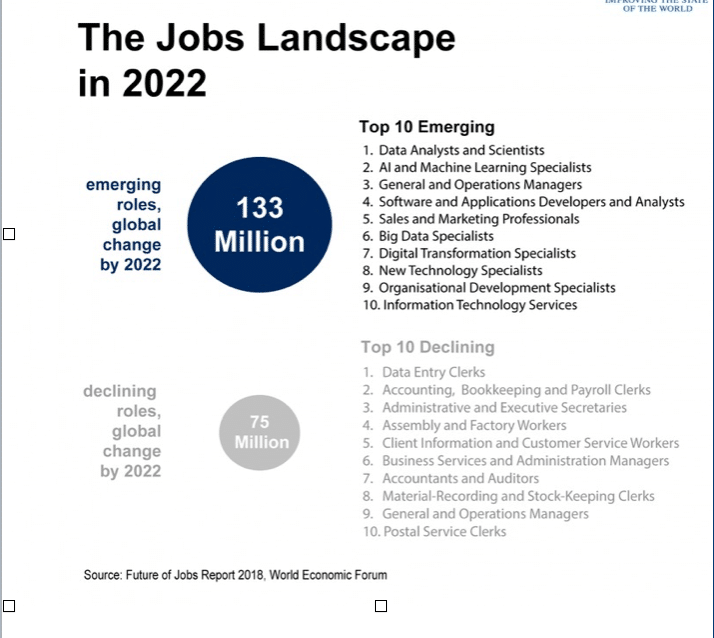Introduction
There is a paradigm shift that we are entering into in terms of the coaching and consulting landscape. That is because many professionals are looking at re-inventing themselves and starting a service-based business. This is great news but requires a very different paradigm to managing a sales, marketing, operations, or finance teams in the corporate landscape.
This article is a high-level framework that will help you understand the key moving parts to starting or scaling a coaching or a consulting business in 2020.
I’m really tired of all the BS in the marketplace because there is so much contradiction. There’s an overload of free information and noise out there, but it’s not serving you, me, or the marketplace on a local and a global level. And really, when you think about it, the world is changing so rapidly as we fully enter the digital economy that to win in the game of coaching within any industry, we need to shift our mindset exponentially.
Right now, we can’t run a business like we did six months ago. The landscape has changed dramatically, and we need to move with it. I’ve been in the tech business since year 2000, and I can tell you that I have never seen so much change, especially as in the last few years. In order for us to succeed as coaches and consultants, we have to get out of our own way and do things like we have never done before.
Let me ask you: Where is your starting point right now?
It’s an important question for you to answer because when I speak to people, their pain point is usually around lead generation. And that’s probably where you’re at right now, right? But your problem actually is not lead generation; in fact, most of you are not even close to starting a lead-generation strategy. In this article you’re going to see why. You can see in the visual below where most people start – at step three, which is lead generation. And usually what they are told by other digital marketers or digital coaches is that they need to build a sales funnel, generate as many leads as possible, get people on a call or sell at the end of a webinar, and then build their coaching course.
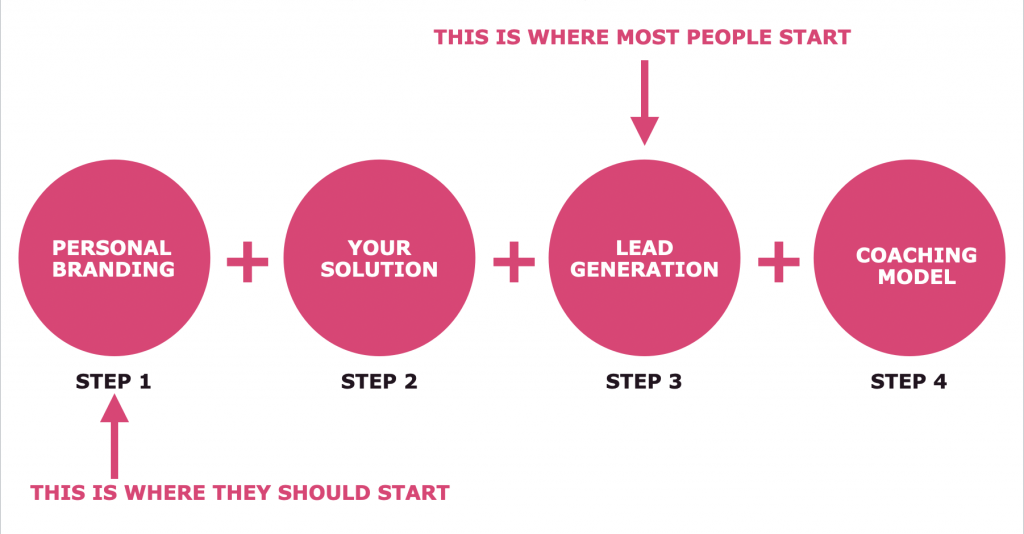
This is not aligned with what the digital economy demands right now. You are going to see why here, and you will understand that your focus on lead generation needs to be on hold. You need to start thinking about steps one and two before you can even consider step three.
Step one is understanding how to build your personal brand in today’s economy and how to unpack it so that it serves you and positions you as an authority, not as someone who wants to get rich or famous quickly. My approach to personal branding is actually different from most people’s, and hopefully you’ll understand why at the end of this article.
Step two is to know your solution and what you bring into the marketplace in terms of solving a problem.
Your business model should not be based on what everybody else is doing because you will get lost in the white noise. It’s no longer sustainable to start a business based on the old narrative.
Your coaching/consulting business needs to be based on facts and figures, a tried-and- tested framework/system that has a start and a promise. It can take clients through a process, and it can solve a complex problem at the end of the day. So, this notion of getting people into a funnel and selling or finding a niche and creating a business around that niche is the old way. What I’m presenting is the new way, a true paradigm shift.
The new coach thinks and acts differently because they know their client commands an end-to-end solution. You have to understand that your prospect today is across every single channel. They are doing their own research. By the time they actually arrive at your front door or on a phone call or in a face-to-face meeting with you, they’ve already done their due diligence. They know what they want; they know what they’re in for. They’re also not after generalists anymore. They want somebody who can genuinely solve their problem. If they want a generalist, all they need to do is ask Siri a question on their iPhone and get answers.
In fact, Gartner did research in May 2019, and they showed the buying cycle of a consumer, especially in the B2B landscape. And it was actually quite interesting; it was like a mind map showing the actual behaviour before they come face-to-face with their preferred supplier. So, don’t underestimate the power that your prospect holds in their hand. By the time they get to sit with you face-to-face, especially if you’re selling in the B2B space, they’re not interested in being pushed out. You need to pull a customer into your world by drip-feeding them content and information of absolute value across multiple touch points before they can believe us and trust you.
This is a critical aspect of social selling, which I’ll cover in the latter part of this article. The coaches you see on Facebook, shouting that they’ve got a sales blueprint that will magically create $1 million per month for you? That doesn’t work. That’s a push strategy. What we’re talking about here is a pull strategy and that’s where LinkedIn works beautifully for this model. Content plays a huge role, and your social currency becomes an absolute priority when you’re building your profile, your brand, your authority across multiple platforms, your digital assets, your website, your offer: All have to be congruent with one another.
Therefore, the messaging needs to be solid, it needs to be consistent, and it needs to flow, so that wherever your prospect lands they’re always getting the same message. This model is different from the way most people are actually starting their coaching businesses, by starting at step number three, which is lead generation. But I want to take you forward and show you that step one, which is personal branding, has 16 moving parts before you get to lead generation. And within those 16 moving parts, there are independent frameworks that must be unpacked, refined, defined, and implemented before you can even think about lead generation.
A long-term business goes through the process that I’m sharing with you today. Your solution must be based on a tried-and-tested framework. Let’s assume that you’ve left out personal branding or you’ve completed your personal branding strategy and you’re quite happy with it. Your solution has moving parts that need to be implemented before you can even think about getting to the lead generation part. This is what 99% of people leave out of the equation.
Coaches who are working in the new paradigm, the disruptors, if you will, have placed massive emphasis and investment in steps one and two before step three. If your personal branding and solution is congruent, lead generation becomes the effect of the cause. Most people are creating lead generation as the cause and then personal branding is the effect of the cause, which doesn’t make sense at all.
Personal Branding
Who you are in your natural state is the first step because most people place emphasis on their values and showing up as being their authentic self under the heading of personal branding. Whilst there’s validity in that, it actually is not that from my standpoint, keeping in mind that I’ve been playing with personal branding for 20 years and built an entire algorithm around it.
Personal branding starts with who you are in your natural state. So, this notion around authenticity does play a role in your natural state, but it’s not about you showing up being you and sharing stories about anything and everything under the sun because you just want to be you today. That’s not strategic and deliberate; it’s a wasted opportunity. What we’re talking about here is about you understanding who you are in your natural state. It actually plays out in every aspect of your day-to-day life, be it personal and or business. Let’s break it down a little bit further, and let’s look at the personal branding attributes and the key drivers of a personal brand in order of importance.
Now you can see in the triangle below that within each aspect of this personal branding model, there are different attributes that need to be defined and refined.
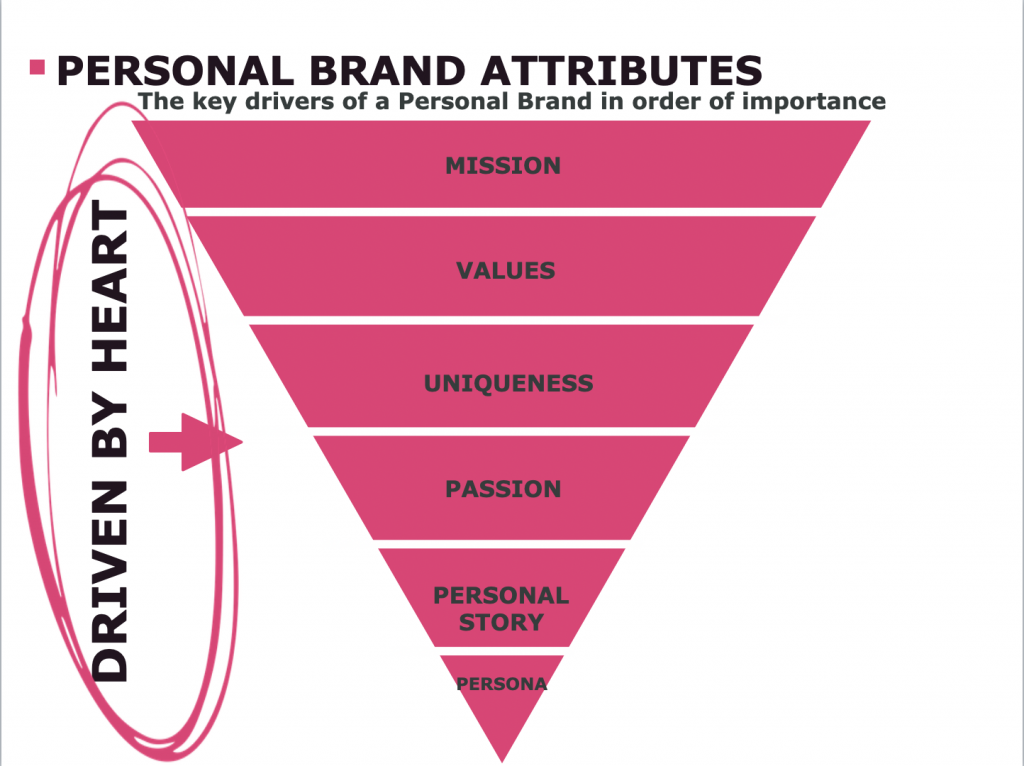
Anyone who’s embarking on a journey of positioning themselves as a personal brand is essentially saying, ‘I want to be known for this thing in the world.’ So, it’s about you owning a piece of real estate in the world that positions you as an authority in your area of expertise. It’s an area that you absolutely know because you have the experience and you can convert that into a tried-and-tested methodology.
Personal brands are not afraid of giving. They’re all about educating and providing value. It all comes from the heart first and most are here to serve. They are not here to get rich and famous quickly.
These people are not driven by fame. They are driven by the legacy that they are going to leave. Therefore, the work that they do has incredible meaning, not just to them but also to the marketplace at large. They place huge emphasis on their values, because it is a bench-mark that is used to validate the type of people that they want to work with, the type of people that they want in their tribe, the type of people that they want to collaborate with in business such as their channel partners or their personal circle. These people place values of the highest importance. It’s the metric that they measure everything against, and if the values are not aligned with the people who want to come into their circle, they have the absolute courage to say, no, we are not a good fit for one another.
These people are not desperate to take anyone on board for the sake of making money. Personal brands in the true sense are not in it for the money. They understand that the money is the effect of the cause, so they are comfortable in saying no to a prospective client. If the values are not aligned, they are clear on their gifts and their talents and they understand how to bring those gifts and talents to life in the real world, especially in the work that they do. These gifts are obvious to other people in the outside world. They could be natural speakers, they could be natural storytellers, they could be fantastic with music or with words or with poetry. It’s just their natural state. It’s the gift that they’ve been given that they utilize in their day-to-day work.
They understand that they have a methodology that’s designed, tried, and tested. They know it works and they want to be known for that. Their personal story is fundamental as part of the personal brand proposition. The personal story for a personal brand is actually 100% connected to their mission.
It’s because of their story that they’re on the mission and the story becomes a conversation starter or the stories within the story become conversation starters. Your story must be congruent with your mission; otherwise, you won’t be believable or trustworthy. If you want to stand out in this new economy as a disruptor in your coaching or consulting business, you need to understand that your personal brand is a fundamental component of your success story. When you unpack your personal brand in the way that I’ve just explained, you no longer will be invisible. Now keep in mind that we still haven’t actually touched on the social selling side, which has a huge impact and connection to your personal brand.
The Solution
Your solution is what makes you stand out. Your solution is the tried-and-tested process that you know inside out. If I gave you a whiteboard marker and I asked you to stand in front of a whiteboard, you should be able to illustrate a tried-and-tested process from start to promise with absolute flow. You don’t need to reference any white papers or PowerPoint presentations or anything other than you. That is what a specialist expert looks like. That’s how you stand out as a brand.
Now here’s the thing that I’m passionate about. Your solution must solve one major complex problem that positions you as a specialist, not a consultant and not a coach. Most coaches think like a job title, which is very transactional. This is a corporate mindset, so if you are transitioning out of corporate right now, this is most likely the mindset that you’re stuck in. You need to step out of a job title mindset and get into a specialist mindset.
A specialist has a combination of skills, wisdom processes, and passion. A consultant is okay if you’re selling directly back into corporate and it requires knowledge and a data-driven approach. That model still does work, but we are moving into a ‘specialized economy’. The World Economic Forum has documented this. The highest earners in this new economy will have not only the ability to solve complex problems and become an authority, but will also position themselves as specialists. And you have to decide which one you want to be. I can tell you that most people that I speak to are still stuck in the job title mindset.
Maybe you’ve been made redundant or left your corporate job. Maybe this is all new to you, but what you need to do immediately is step out of a corporate mindset. When you step into a coaching or a consulting role, you’re stepping into entrepreneurship and that requires a quite different mindset. I remember that 24-hour period transition from my phone, literally being a hotline, hundreds of emails each day, traveling on a plane twice a week, to 24 hours later when I was transitioning into an entrepreneur. No phone calls, no emails, no travel, uh, no team members.
It was just me. And that was really confronting, because I had to transition my mindset from corporate to entrepreneur. So, ask yourself honestly: Where am I? Am I still stuck in a corporate mindset or am I ready to transition?
Here are some facts. This is what the world economic forum has documented, which is all public knowledge. By 2022, the top 10 emerging jobs will be data analysts and scientists, AI and machine learning specialists, sales and marketing professionals, big data specialists, digital transformation specialists, new technology specialists, and organisational development specialist.
You can see that being a specialist is exactly where you need to be and how you need to be thinking. If what you do fits into one of these 10 areas, you can be sure you will have a long-term sustainable business. The skills outlook by 2022 is also interesting. Analytical thinking, active learning, creativity, originality, initiative, critical thinking, complex problem solving, leadership and social influence are key skills.
What I’m talking about here are specialists in their field. Their solution delivers micro transformations with every step, regardless of whether their solution is delivered one-to-one or workshop or an online course; it’s the same content. The methodology doesn’t change; only the delivery of the solution changes. The effect of their personal brand combined with their transformative solution converts their clients into brand ambassadors. This in turn creates a tribal effect: Their clients advocate for them because they’ve had an ecstatic experience.
And what does this equal?
The new coach is not looking for a niche and building a business around a market they know nothing about. They are specialists. They know their target audience and understand their pain points. Do you understand what I’ve just said here? This goes completely against what all of the guru coaches are teaching and pushing out on social media. They’re saying, go out there, find a niche, understand their pain points, and build a business around that. The new coach is completely different. These are people who know their target audience. They know that a problem exists in their industry, niche, the marketplace, inside a corporation, and they have a solution to the overarching problem, which is called a complex problem.
They know how to fix that complex problem because they’ve had years of experience. They’ve also got wisdom to bring into that mix. This is a different mindset and paradigm versus what everybody else is pushing. This is a long-term sustainable business model.
So based on that understanding, your personal brand and your solution have to be congruent. They must have a direct link to your mission. The mission is the glue to everything that you do in terms of building your brand proposition. That’s the heart of why you’re doing what you’re doing. Once you have solidified those two aspects of your business and you have defined, refined, and implemented these moving parts, you are in business; you’re ready for monetisation. You’re ready for lead generation — what I call social selling.
Social Selling
As I said, lead generation has to be strategic and deliberate every step of the way if you want to build a sustainable coaching business. A lot of the gurus out there are talking about personal branding based on the notion of just showing up and being authentic. I disagree with that. I’m already authentic and so are you. Our DNA is unique; therefore, mine makes me authentic. I could never be exactly the same as you even if I tried. Lead generation, especially using a platform like LinkedIn, is not about showing up and being authentic and creating random content.
That’s not strategic; that’s not deliberate. If you’re on a platform like LinkedIn to build your business and generate leads, you have to think about being strategic and deliberate so your content actually does the pre-selling for you. You can’t just show up on a platform like LinkedIn and start talking about cats and dogs in some random content that makes absolutely no sense. You can do that if you want to be on the platform to just play, but if you’re actually on it because you want to build a coaching and consulting business and you’re pretty damn serious about it, then you need to be strategic and deliberate because it makes your sales process way easier.
I can tell you without a shadow of a doubt that at least 95% of the influencers on LinkedIn are promoting themselves as influencers and coming across as very successful, but they are not monetising at all. Their content doesn’t do justice to them because most of these people are looking for vanity metrics. That’s not what we’re doing here. We’re actually unpacking you as a business and positioning you as a brand on a social platform like LinkedIn. So, let’s start to look at LinkedIn in a little more detail and see what it is that you need to know.
The first thing in your shop front is absolutely critical. You’ve got to be taken seriously. If you are going to use LinkedIn for social selling, which I recommend that you do, your shop front is key to your success.
The header, the profile photo, and the profile title really need to be succinct. You can see here my branding colours are all over my profile: They match my posts, and they match my website presence. Everything that you see that has my name on it has the same colours on it and I never divert from that. My LinkedIn profile matches every aspect of my brand. It’s congruent. The first thing that you need to do after you finish reading this article is get serious about upgrading your profile and make sure you meet LinkedIn’s All Star status.
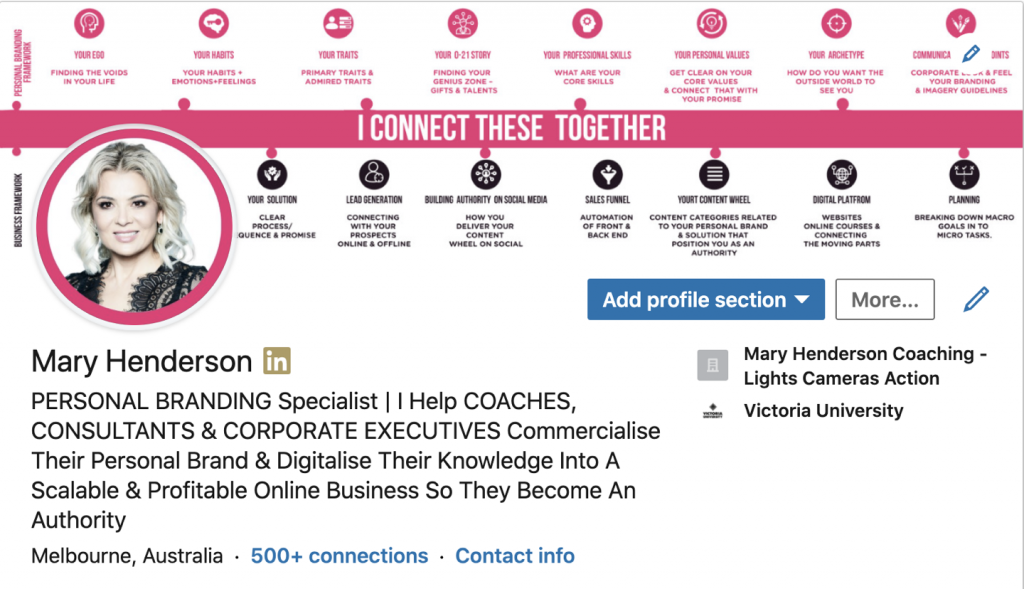
Your professional photo and your profile title should articulate what you do, who you serve, and what you promise. This is a priority. If LinkedIn is your platform of choice for social selling, there are two sides to the coin regarding social selling: the front end, which is your content, and the back end, which is social selling. The front end builds social currency, and the back end generates your leads.
To understand how the content works on LinkedIn, you must have a strategic and a deliberate content strategy. And essentially it starts from the notion of getting to know you. It’s about your values; it’s about people feeling your values and knowing what you stand for.
This type of content is all about getting to know you. It’s a little bit more touchy-feely. Then there’s getting to like you and showing what you do and who you serve. This is where you start to position yourself as an authority, so it’s important to get people to like what it is that you have to say. The final part is your promise, which essentially is trust. Now your content has to fit these three metrics. Know, like, trust. I know we hear it all the time, but I don’t think people really understand what it means. For somebody to get to trust you on social media, there have to be a hell of a lot of touch points before they actually arrive at the trust factor.
If you’re going to show up on social media, especially LinkedIn, and post once a week and hope for the best, you’re probably going to never reach the trust factor. If you’re going to post three times a week, that’s okay, but it will take a little bit longer. If you post every day except say weekends, that’s a fantastic approach because you’re creating a lot of touch points each week, and people get used to your style, your approach, your values, your quirkiness, and your expertise. Also, when you get them to trust you, essentially you’re asking for them to do something. It’s a lot easier for people to say yes to a call to action after they’ve felt you, understood you, and liked you, say over 20 or 30 posts rather than just one post.
You should be asking yourself, ‘How serious am I about building my coaching business into a $20K, $30K, $50K, a $100K business per month?’ If you’re serious about it, then your content strategy needs to play a huge role. So, on your task list, for example, every day has content strategy on it. You need to do something every day in terms of your ‘to do’ list that incorporates content.
You need to understand your prospects exceptionally well. The new coach who can solve a complex problem, understand their audience, know the pain point, also knows how their prospects and clients want to consume content.
Now, these are some of my own personal metrics to show you what happens when you have a strategic content strategy. In 12 months from 20th of July, 2019 until 23d of July, 2020, I just took a screen grab of my metrics and you can see all of my content combined on LinkedIn had over 1.7 million views, over 44,000 likes, and 23,000 comments. I’ve had 282 posts. But the most important metric I want you to notice is the engagement rate, which is 4.01%. My friend Dennis Yu, who is a global expert on social media algorithms, said to me, ‘If your engagement on LinkedIn is 1% – 2%, you are doing exceptionally well.’ When I told him that my engagement rate was averaging 4%-5%, he couldn’t believe it.
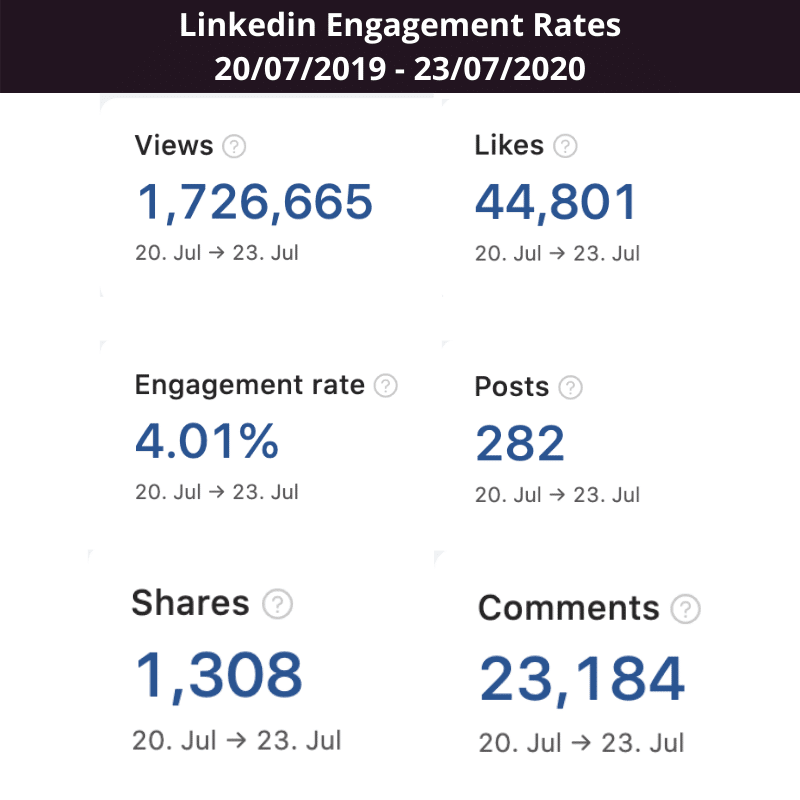
This metric tells me that my target audience loves what I bring to the table because a lot of my posts get very high engagement and when I say engagement, I’m not talking about emojis and one-word answers. I’m talking two to three paragraphs of engagement. We’re having big discussions in my posts. So, this engagement rate of 4.89% is an important metric that we must understand and aim for. As I said, 2% is fantastic, 3% is brilliant, 4.89% is outstanding. This is proof that when all of the moving parts that I’ve shared with you in this article are congruent and glued together, the content you create does all of the heavy lifting for you. It does all of the pre-selling for you. What you need to do is be available for that call or for that one-to-one meeting so you can close the sale.
Your backend is lead generation. That’s where it all happens. That’s where the money machine actually is. I want you to think of LinkedIn as networking 24/7, 365 days a year or better still, it’s networking on steroids. It’s the only way that I can describe what it’s like to network on LinkedIn, both on the front end, the people you meet. and the backend. What do I mean by the backend? I’m talking about the toolbox that you need to actually start the conversations to generate leads with your target audience. That’s with Sales Navigator, the premium account. For $99 per month, you get a tool that can generate unlimited leads for you versus being on Facebook, which is what all those gurus are pushing.
The gurus are spending anywhere from $10K – $100K per month on Facebook advertising to get people into their webinars and try and close sales. They are generating thousands and thousands of leads and only closing something like 1% -2%. Of course, they only need to close a handful of sales to deliver a decent ROI. That’s a push strategy and it costs a lot of money. It means that you have to find at $3K – $10K per month to actually spend on advertising to generate that level of lead generation versus $99 per month on LI to get this incredible toolbox to target the right prospects, and also start a conversation with them. To me, this is far more powerful than generating thousands of leads with random people who essentially want free information.
The other thing about Sales Navigator is it’s granular. You can actually search by keyword, industry, relationships, geography, the school they went to, the title, etc. For me this has been a game-changer.
LinkedIn does give all of us a free search function, and you can still generate leads just using the basic search function. It’s not granular, but it is a starting point, and I think that’s something that you want to know if you just want to test the waters.
When you reach out to your target audience, and ask to connect with them, if you’re getting less than 40% acceptance rate, there’s something wrong. You need to aim for a 50% to 60% acceptance rate, which is an indicator that they resonate with what you do. When you’re connecting with somebody on LinkedIn, you have to start a conversation from a like-minded zone and then you’ve got to move the conversation down your sales funnel without having a sales funnel. The sales funnel actually is the conversation you are having in the LinkedIn messages so you can eventually have a face-to-face meeting.
Next, you have to know your metrics. You have to understand how many leads you need to generate in order to meet your sales goal at the end of the week, the month, and the year. You need to understand how many people you need to connect with on a month-to-month basis, and how many conversations you need to have. I met somebody recently and he said that he starts a conversation with his services and what he sells. I asked him what his acceptance rate was and he said about 5%. So, you can see the difference between starting a conversation from selling versus starting a conversation from adding value, which is what I do. That’s why my connection rate sits at around 60%. Remember that you’re not selling at all. You’re starting a conversation from a like-minded zone and this is really important on LinkedIn.
You’re a specialist. You want to be seen as the industry expert. This can only be achieved if parts one and two that I have presented are fully implemented. If they’re not, the effect does not happen, because there are 16 moving parts before the profit outcome happens.
There is a new paradigm taking place. You want to be on that wave. This is like the blue ocean strategy. You want to be the disruptor in your industry. You want to be a solution to
a problem so you have the power to pull people towards you.
The next step is up to you. If you need help in digitalising your knowledge and commercialising your brand, please book a free 45-minute strategy call with me and let’s talk and dive deeper.

